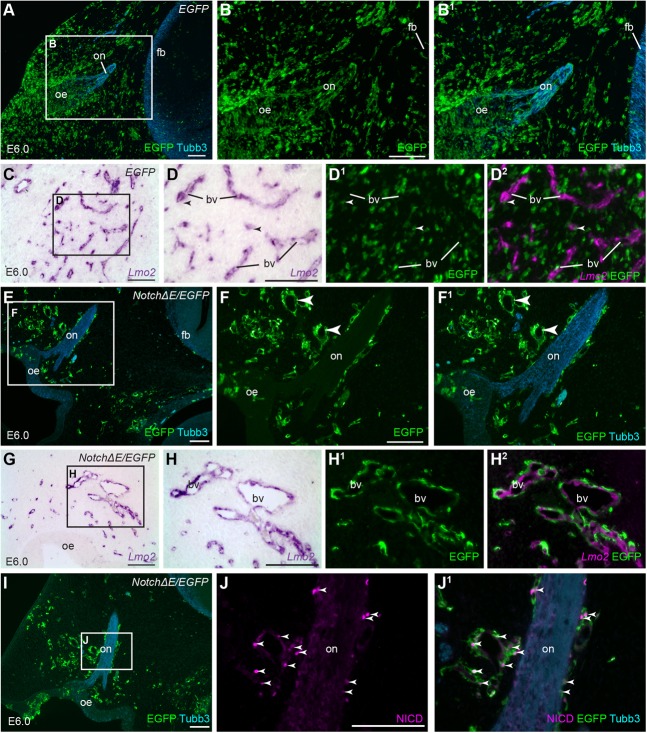Fig. 1.
Constitutive Notch activation from E4 causes frontonasal mesenchyme cells to associate with vascular endothelial cells. Parasagittal sections of the olfactory region from chicken embryos in which the cranial ectoderm had been targeted in ovo at E1 with EGFP alone (control) or NotchΔE/EGFP, using the Tol2 transposase/‘Tet-on’ electroporation system (Sato et al., 2007; Watanabe et al., 2007). Eggs were injected with doxycycline at E4. (A-B1) A control EGFP-targeted embryo at E6. Immunostaining for EGFP and Tubb3 reveals EGFP-targeted cells throughout the mesenchyme and along the olfactory nerve, as well as in the forebrain, surface ectoderm and olfactory epithelium. (C-D2) In the same embryo at E6, EGFP-targeted cells are uniformly distributed in the frontonasal mesenchyme; only a few are associated with Lmo2-positive vascular endothelial cells (arrowheads in D-D2 highlight examples). (E-F1) A NotchΔE/EGFP-targeted embryo at E6. NotchΔE/EGFP-targeted cells aggregate in rings in the frontonasal mesenchyme (arrowheads in F,F1) and at the edges of the olfactory nerve. (G-H2) In the same embryo at E6, NotchΔE/EGFP-targeted cells encircle Lmo2-positive vascular endothelial cells. (I) The same NotchΔE/EGFP-targeted embryo at E6 shown in E-F1. Immunostaining for EGFP and Tubb3 shows rings of NotchΔE/EGFP-targeted cells in the frontonasal mesenchyme and along the edges of olfactory nerve. (J,J1) Higher-power view of the boxed region in I. Immunostaining for the cleaved Notch1 intracellular domain reveals co-localisation with NotchΔE/EGFP-targeted cells (arrowheads highlight examples, both in the mesenchyme and at the edges of the olfactory nerve). bv, blood vessel; EGFP, enhanced GFP; fb, forebrain; NICD, cleaved Notch1 intracellular domain; oe, olfactory epithelium; on, olfactory nerve. Scale bars: 100 µm.

